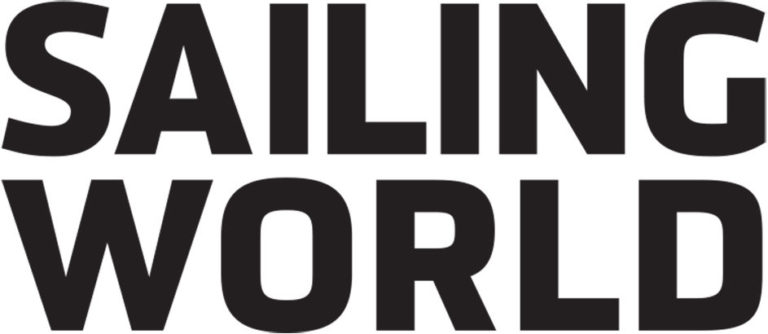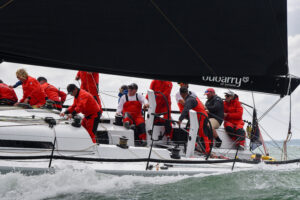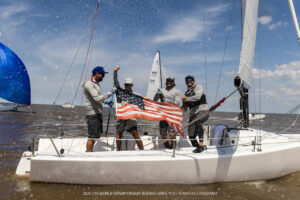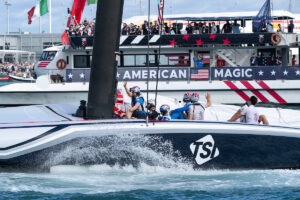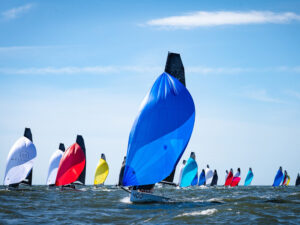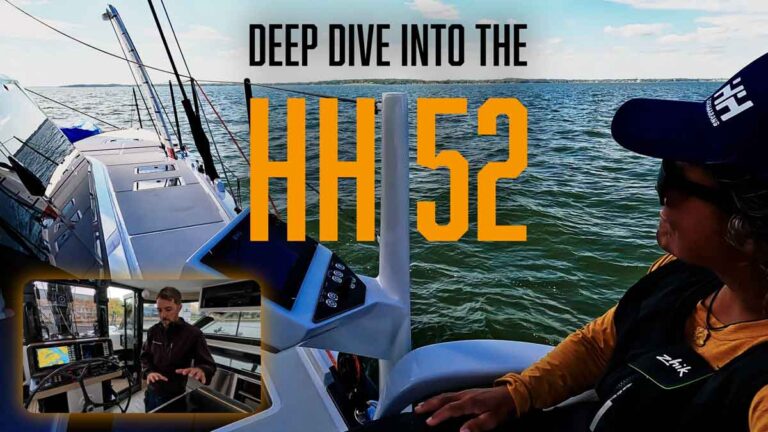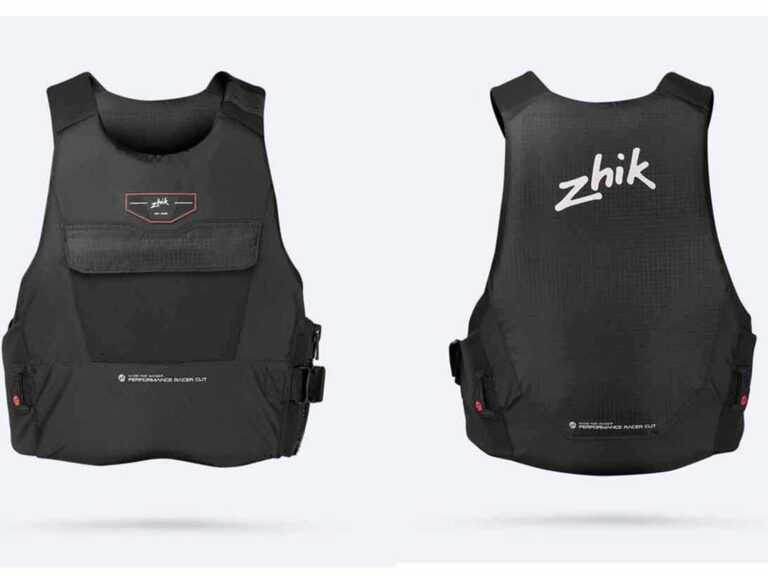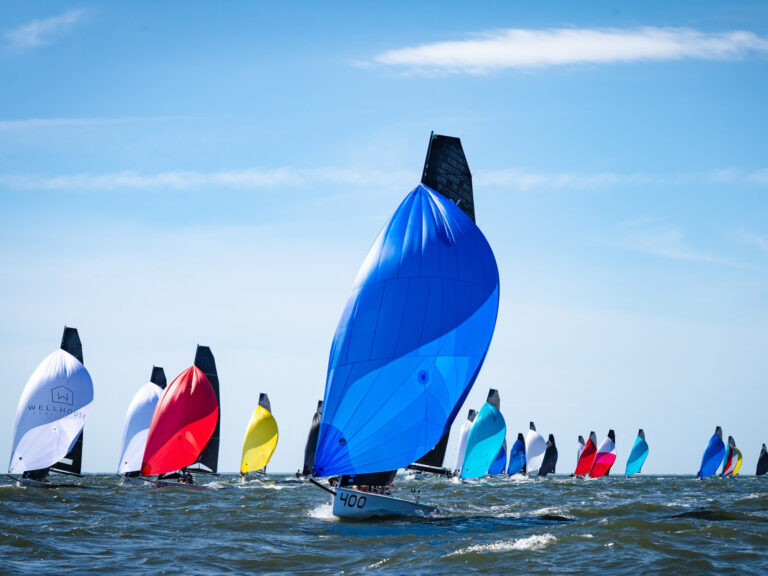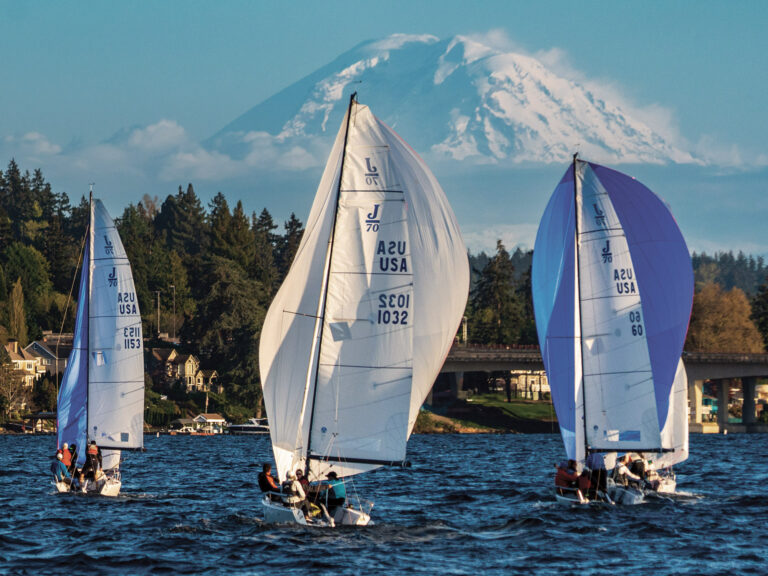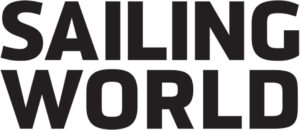
The Royal Ocean Racing Club’s now-classic Caribbean 600, which starts and finishes in Antigua after snaking through nearly a dozen islands, once again provided perfect conditions. On start day in mid-February, the fleet set off in 16- to 20-knot easterly trades, beating toward Antigua’s windward side. On board Bryon Ehrhart’s 88-footer, Lucky—a machine that likes reaching more than beating—we couldn’t wait to get to the top, crack sheets, and show the fleet what this monster is capable of. After weaving through the early starters and swapping tacks with the upwind-oriented boats in our class, the moment came to get the fractional code zero on the stick.
Our plan was to sail triple-headed to Barbuda, a 120-degree true-wind-angle reach. Lucky’s skilled foredeck team and sailhandlers got the required sails on deck, plugged them in, and prepared for launch, all while fire-hose conditions swept the deck. These are the guys who make it happen. With reaching sails deployed and the final upwind workhorse bagged, the boat locked in at 20 to 25 knots of boatspeed at 25 degrees of heel, and the fleet was left in our wake. We had a 5-mile lead after the 35-mile leg to Barbuda. That is what Lucky was built to do.
Built in 2013 and campaigned by George David as Rambler 88, this Juan Kouyoumdjian design is an ocean slayer, built to win line-honors trophies and smash records when the conditions permit. Ehrhart, a longtime ocean racer, insurance executive and a robotically nice guy, took on the project two years ago. He began his international ocean-racing projects in 2006 with a TP52 of the same name, which he and his crew sailed the absolute bottom off. After that, he moved on to a Reichel/Pugh 63, on which I had the pleasure of sailing with him, winning the Newport to Lizard Transatlantic Race in 2015. From the 63, Ehrhart upgraded to a Maxi 72 and now the 88-foot Lucky. When he sponsored the 88, he knew that he needed a top-notch crew—and it just so happened, the boat came with one.
Led by Brad Butterworth, this team is as deep is it gets. They’ve sailed so many miles together that the efficiency and fun are palpable and infectious. Where other crews brief before maneuvers, these guys look at each other, utter a couple of pleasantries, and then get the job done as seamlessly and as skillfully as possible.
I had the pleasure of sailing with this group many moons ago on the Judel/Vrolijk 66 Numbers, owned by Dan Meyers. Back then, I was the lowest guy on the totem pole. My original job was to pack kites on board, fix them at night, drive trailers to and from regattas, and speak only when spoken to. Fifteen years later, I’m glad they’ve accepted me back. Despite my new “watch captain” title, I still try to operate like the guy who shoehorned his way in as a 20-something looking for an industry foothold, and if it weren’t for one of Ehrhart’s amazing initiatives, I’d still be the nipper.

Ehrhart has mandated that the boat always have six American under-30s working in the program and sailing races when opportunities arise. Trust me—the deliveries, preparation for each race, and boatwork are hard. These youngsters work long hours under the tutelage of some of the toughest cookies in the business. Stu Wilson is Lucky’s boat captain, and he’s in charge of the workforce. He runs a tight ship and is developing their skills to a level where they can lead future race programs. They learn to respect and develop the skills, intensity and precision necessary to compete at a high level. Sam Rosenbaum was able to do the transatlantic race with us this past winter, becoming a 21-year-old record holder, and Luke Tougas raced the 600 with us, an experience that other 19-year-olds can only dream about.
Tougas pitched in everywhere he could as the boat careened through the Caribbean daylight and darkness. On a boat like Lucky, in this race, you don’t usually go more than a watch without a maneuver or a sail change, except for the long run from St. Martin’s Tintamarre Island to Guadeloupe. The lee of Guadeloupe can often determine the race’s winner. When you get there has a huge impact on what diurnal effects you experience. We got there midmorning, less than 24 hours into the race, and were met with leftover drainage that would soon give way to some thermal reverse flow. The keen eye of Juan Vila, our navigator, helped us keep the boat in pressure and get back to the accelerated gradient on the far side of the island. As the proverbial canaries in the Guadeloupe coal mine, we watched our rivals on the 100-foot Leopard close up on us, but as soon as we were back into the trades, we didn’t need to look back.
Other than one squall line that we were able to play to our advantage between La Désirade and Barbuda the second time, it was straightforward. After a long, final 30-mile beat from the island of Redonda to Antigua, we were crowned line-honors champions—another great result for Ehrhart, a crew of grizzled veterans, and a young guy who’ll never forget the experience. Whether it’s 0600, which is when we finished, or happy hour, there’s one thing you can count on with this race: flats of cold Carib lager that the race organizers deliver to the boat when the dock lines are taut. This race is an exhausting sprint for a boat like Lucky and its crew. It’s an accomplishment that deserves to be celebrated—and an easy reminder that I’m lucky to be included.
